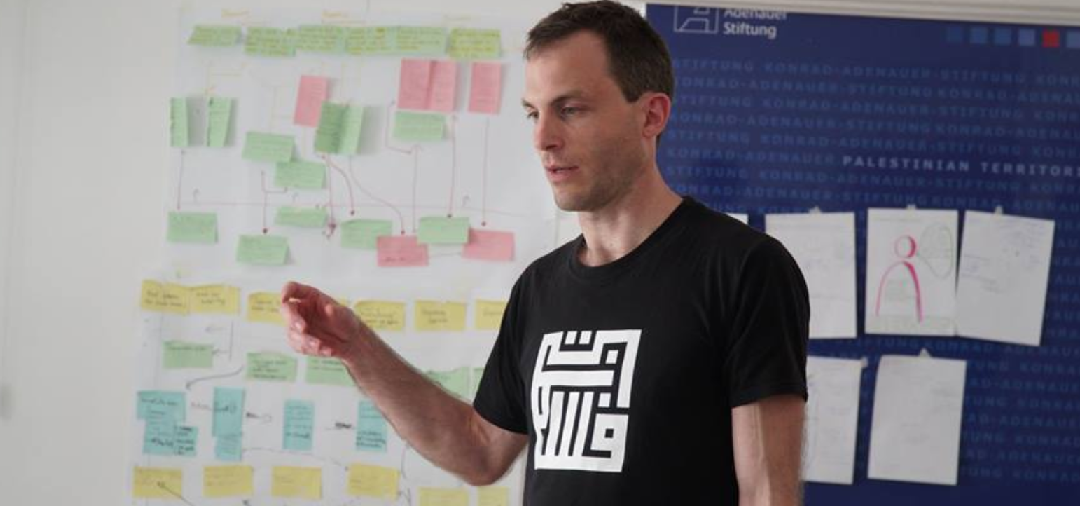We were joined by human-centered design expert – Johannes Landstrofer – for two sessions; our monthly BUILDx event, and one of our four quarterly expert workshops.
Johannes Landstrofer currently works as Coordinator Digital Agenda with the German Caritas Association and is directly assigned to the board of management. Before that, he worked for 10 years with design consultancy IXDS, analyzing manufacturing processes in Bosch factories, researching user needs for Deutsche Telekom or consulting Wikimedia Germany. We were able to benefit from his insights at BUILDx and the expert workshop.
Both events addressed human centricity, service design, and co-design. Check out the learnings from each of our sessions:
BUILDx: Human-centered design as a key in digital transformation
We hosted our BUILDx session at Fikra – PalTel Innovation Hub. Johannes started the session by sharing the famous Steve Jobs quote to describe design: “Design is not just what it looks like and feels like. Design is how it works.” Service design attempts to capture a service journey to create a holistic user experience. Johannes explained that design is the way things interact with each other. And that in both service design and interaction design, the designer should consider the steps beneficiaries, or users, take in their user journey.
On Empathy
Johannes described a shift in the industry. “You do not design for yourself or out of your creativity. You go out and ask people. It’s no longer about having a design genius.” Today, design is about asking people what their problem is, stepping into their shoes, and creating a service that matches their needs and solves their problem(s). It wouldn’t make sense to design a great product that no one needs.
What differences exist between the for-profit sector and the non-profit sector in terms of service design?
One of the main differences between the for-profit sector and the non-profit sector is that in the for-profit world, you often provide your offering to your customer, who are also your paying beneficiary. In the non-profit world, the structure is different – Johannes describes it as a triangle. You have 3 different stakeholders, the organization, the beneficiaries (who are often not paying for the product/service), and the donor or grant organization. Each of these stakeholders has a motivation. So when doing your user research, it’s important to differentiate and to balance the 3 stakeholders, and 3 motivations. You can apply similar tools in both sectors, but in the end they need to reflect two-sidedness or triangle situation.
How do you transfer methodology into the social space?
You use your target group, the people, and you adapt your methodology to the triangle described above. It may feel new to some non-profit organizations, but that’s the challenge. Johannes also reiterated that empathy is a tool that should be adapted into the social space.
Moreover, Johannes underscored the need to adapt to the digital “revolution”. He referred to the digital transformation as a large one that affects society as a whole and organizations on a smaller scale. If the organization wants to stay relevant it needs to adapt to digital transformation to be able to provide relevant answers.
The importance of co-design was highlighted, and so was its role in involving stakeholders in the design process in today’s day and age. Traditionally speaking, innovation units are usually fenced off because they’re working on “secret” organizational projects. Whereas the empathic way is the other way around – you open up and invite people to share thoughts. And according to Johannes, that’s where you create connections towards your future beneficiaries.
The session’s moderator, Derrar Ghanem, agreed with the above, and concluded with “When you give people the opportunity to innovate, that’s where the magic happens.”
Expert Workshop: How do you put users in the center (or in your team) to help you innovate?
This was the first of four annually planned expert workshops. The workshop delved more into the details of service design as a process. Johannes explained how service design is a plan to put a business model canvas into action, and how user need is linked to empathy, and understanding user needs.
The workshop included 8 participants from 6 different organizations. We applied the Service Design Blueprint to two of the participating organizations’ works; Grassroots Jerusalem’s tours, and Esnad’s 7essa program.
The workshop participants broke into two different teams and dove into breaking down the user experience for each of the projects. Different steps in the use journey were identified and enhanced through presentations and feedback. Other concepts like “the backstage” or “the bottom of the iceberg’ were addressed as well.
The workshop ended with a final presentation from each of the teams, and final comments from Johannes and the participants. We were very happy to hear everyone’s reactions to the workshop:
“We’re truly amazed by what we did today, wallah.” – Yazan, Grassroots Jerusalem
“I added a lot of things to the user experience of my product, many concepts and steps I hadn’t considered, and it was very helpful.” – Jihad Shojaea, 7essa

